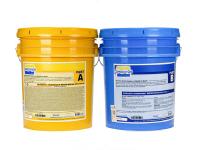Mold Star™ 20T /36 kg
Mold Star ™ 20T est un silicone platinum translucide de dureté Shore 20A, facile à utiliser, le rapport de mélange étant 1A:1B en volume, une balance n'est donc pas nécessaire. Il possède une viscosité relativement faible et le dégazage sous vide n'est pas nécessaire pour la plupart des applications. Le temps de travail est de 6 minutes et le temps de démoulage est de 30 minutes à température ambiante 23°
Mold Star ™20T polymérise en un élastomère souple et solide qui est résistant à la déchirure et présente un très faible retrait à long terme. Les moules conçus avec le Mold Star ™ dureront très longtemps dans votre bibliothèque de moule, idéal pour la coulée de cire, plâtre, résines, béton et autres matériaux. Le silicone Mold Star ™20T peut être épaissi avec Thi-Vex® épaississant pour une application au pinceau.
Un nombre infini d'effets de couleur peut être obtenue en ajoutant les pigments Silc PIG®, SilTone, SAMMold Star ™ 20T résiste à la chaleur jusqu'à 232°C et est appropriée pour le moulage d'alliages de métaux à basse température de fusion.
Remarque: Ce produit ne polymérisera pas au contact de surfaces contenant du soufre, même lorsque celles-ci sont scellées.
|
|
Safety - Use in a properly ventilated area (“room size” ventilation). Wear safety glasses, long sleeves and rubber gloves to minimize contamination risk. Wear vinyl gloves only. Latex gloves will inhibit the cure of the rubber.
Store and use material at room temperature 23°C. Warmer temperatures will drastically reduce working time and cure time. Storing material at warmer temperatures will also reduce the usable shelf life of unused material. These products have a limited shelf life and should be used as soon as possible.
Cure Inhibition - Addition cured silicone rubber may be inhibited by certain contaminants in or on the pattern to be molded resulting in tackiness at the pattern interface or a total lack of cure throughout the mold. Latex, sulfur clays, certain wood surfaces, newly cast polyester, epoxy or urethane rubber my cause inhibition. If compatibility between the rubber and the surface is a concern, a small-scale test is recommended. Apply a small amount of rubber onto a non-critical area of the pattern. Inhibition has occurred if the rubber is gummy or uncured after the recommended cure time has passed. To prevent inhibition, one or more coatings of a clear acrylic lacquer applied to the model surface is usually effective. Allow any sealer to thoroughly dry before applying rubber.
Even with a sealer, Mold Star™ 20T will not cure against surfaces containing sulfur. If you are not sure if your clay contains sulfur, do a small compatibility test before using for an important project.
Applying A Release Agent - Although not usually necessary, a release agent will make demolding easier when casting into most surfaces. Ease Release™ 200 is a proven release agent for releasing silicone from silicone or other surfaces. Mann Ease Release™ products are available from Form X
Because no two applications are quite the same, a small test application to determine suitability for your project is recommended if performance of this material is in question.
Measuring & Mixing - Before you begin, pre-mix Part A and Part B separately. After dispensing required amounts of Parts A and B into mixing container (1A:1B by volume or weight), mix thoroughly making sure that you scrape the sides and bottom of the mixing container several times.
Optional... Vacuum Degassing - Although not necessary, vacuum degassing helps eliminate any entrapped air in pourable silicone rubber. After mixing parts A and B, vacuum material for 2-3 minutes at 29 inches of mercury, making sure that you leave enough room in container for product expansion.
Pouring - For best results, pour your mixture in a single spot at the lowest point of the containment field. Let the rubber seek its own level. A uniform flow will help minimize entrapped air. If using as a mold material, the liquid rubber should level off at least 1.3 cm over the highest point of the model surface.
Curing - Allow mold rubber to cure for 30 minutes at room temperature 23°C before demolding.
Heat Curing - Time to demold can be reduced with mild heat. Example: After pouring Mold Star™ 20T at room temperature, place the mold in a hot box or industrial oven at 60°C. This may reduce the demold time substantially. Note - time will vary depending on mold thickness.
Making a Brush On Mold? - Mold Star™ 20T silicone can be thickened with THI-VEX™ thickener for brush-on application and effects. Do not use other Mold Star™ Series silicones for brush on mold making.
Mold Performance & Storage - The physical life of the mold depends on how you use it (materials cast, frequency, etc.). Casting abrasive materials can quickly erode mold detail, while casting non-abrasive materials (wax) will not affect mold detail. Before storing, the mold should be cleaned with a soap solution and wiped fully dry. Two part (or more) molds should be assembled. Molds should be stored on a level surface in a cool, dry environment.
